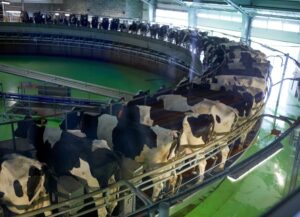Alvaro Garcia
Mastitis continues to be one of the top two health issues (lameness is the first) in US dairy farms, and one of the main culling reasons. Mastitis is the result of either contagious or environmental bacteria causing inflammation in the udder. Contagious bacteria are spread from a cow with an infected udder to a healthy cow. Environmental bacteria come from the cow’s environment (bedding, soil, manure, etc.) and thus are highly influenced by management practices.
Mastitis can be classified in subclinical or clinical. In subclinical mastitis immune cells (neutrophils) are abundant in the udder and milk appearance is not affected, somatic cell counts (SCC) in milk usually increase above 200,000 cells/ml. In clinical mastitis there are other signs and changes in the udder, milk appearance, and sometimes overall health of the cow. Antibiotic treatment has been the norm to deal with mastitis problems. Indiscriminate use of antibiotics however has resulted in a growing concern of antibiotic resistance. It would thus be very helpful to develop diagnostic or monitoring tools to identify susceptible cows and work closely with them before the problem arises. Traditionally SCC has been the detection method, however it is only useful once the cow has calved, and indicates the udder is already challenged by bacteria. Research has shown subclinical mastitis is usually preceded by a non-severe chronic inflammatory state, with the elevation of several blood variables associated with immunity.
A recent study (Zwierzchowski et al., 2020) conducted in Canada looked at the identification of potential biomarkers for subclinical mastitis. Cows having naturally occurring subclinical mastitis (more than 200,000 SCC) were selected for that study. The controls were healthy cows with no clinical signs or any other metabolic disease and SCC of less than 200,000. All cows were fed TMR to meet or exceed the NRC nutrient requirements of dry and early lactating dairy cows both before and after calving.
Urine samples for metabolomics analysis were collected from each cow at 5 time points: at 8 weeks (53–59 days) and 4 weeks (25–31 days) before calving; after calving sampling was during the disease week and at 4 weeks (25–31 days) and 8 weeks (53–59 days) post calving. The hypothesis was that cows diagnosed with subclinical mastitis postpartum could have urine metabolite alterations that would start early in the dry-off period, which will continue into the lactation during the mastitis diagnosis and thereafter.
Two acylcarnitine (C3:1 and C18:2) in urine, were consistently higher during the entire experiment (at −8 and −4 weeks, at diagnosis week, and at +4 and + 8 weeks postpartum). It was speculated that the increased concentrations of acylcarnitine in serum and later in urine could be the result from a disruption in fatty acid metabolism. During this disruption cytotoxic acyl-CoA intermediates accumulate in serum, are then converted to ACs, which are finally eliminated through the urine. These acyl-carnitines have been suggested as activators of proinflammatory molecule response including the tumor necrosis factor, the toll-like receptor ligands, and T-cell receptors.
Another important finding of this study was that pre-subclinical mastitis, subclinical mastitis, and post-subclinical mastitis cows showed alterations in phospholipid metabolites in urine. Urinary concentrations of several very long-chain phosphatidylcholine were lower in pre-subclinical cows starting at −8 weeks prepartum and up to +4 weeks after calving. Several amino acids were found in urine of both healthy and subclinical mastitis cows.
The overall findings showed pre-subclinical, subclinical, and post subclinical mastitis cows showed modifications in urine metabolites associated with lipid, carbohydrate, and amino acid metabolism. It was possible to identify 14 metabolites in urine including Hydroxybutyryl-L-carnitine, Hydroxypropionyl-L-carnitine, Hydroxyhexanoyl-L-carnitine, Methylglutaryl-L-carnitine; Tetradecenoyl-L-carnitine, and Octadecadienyl-L-carnitine. Amino acids identified were Asparagine, Carnosine, Glutamine, Histidine, Serum Symmetric Dimethylarginine (SDMA), and Threonine. These were all measured as elevated during the dry period in weeks −8 and −4 and later during the week of subclinical mastitis diagnosis.
The authors suggested to use those metabolites to distinguish healthy cows from those with subclinical mastitis. These results show promise for their potential to develop future practical testing tools to predict individual cow’s propensity to develop subclinical mastitis.
Reference
Zwierzchowski, G., Zhang, G., Mandal, R., Wishart, D.S., Ametaj, B.N. 2020. Mass-spec-based urinary metabotyping around parturition identifies screening biomarkers for subclinical mastitis in dairy cows. Research in Veterinary Science. 129: 39 – 52.
© 2020 Dairy Knowledge Center. All Rights Reserved.









